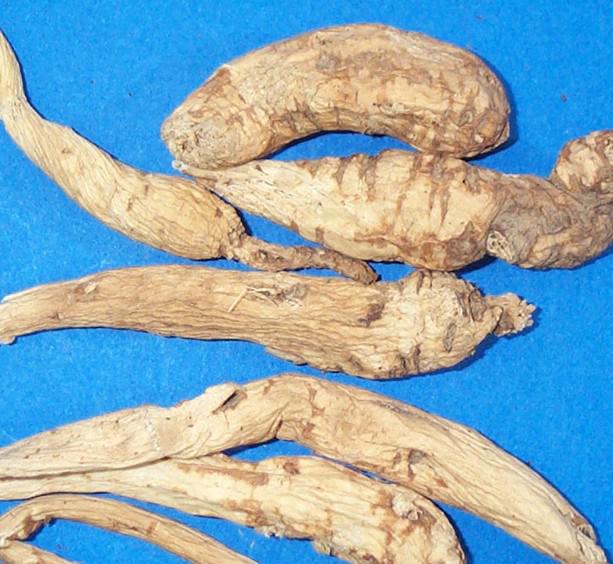Medicinally adenophora mainly refers to the root of Adenophora tetraphylla (Thunb.) Fisch. and Adenophora Stricta Miq. In addition, other species of the same genus in Campanulaceae are also used medicinally. They are Adenophora hunanensis Nannf., Adenophora khasiana (Hook. F. et Thoms.), Adenophora potaninii Korsh, Adenophora pereskiifolia, Adenophora capillaris Hemsl., Adenophora polyantha, Adenophora axilliflora, Adenophora stenanthina (Ledeb.) Kitag, Adenophora coronopifolia Fisch., Adenophora buueyana Diels, Adenophora lilifolioides Pax et Hoffm., Adenophora paniculata Nannf., and more. Hence, other names of this herb include Radix Adenophorae in Latin name, root of straight ladybell, and so on. In China, it is mainly produced in Anhui, Jiangsu, and Zhejiang. It is usually collected in Spring and Autumn. The following steps are to remove fibrous roots, scrape off raw bark when it is newly dug up, clean, dry, and cut into thick slices or short segments. And it is used raw.
Adenophora tetraphylla is a perennial. Stout root is carrot-shaped and with wrinkles. Erect stem is single and 60 to 150cm in height. Leaves are in 4 whorls, sessile or with a short handle; blade is elliptic or lanceolate, 4 to 8cm long, 1.5 to 3cm wide, and with serrate margin, green upper surface, and pale green and densely pubescent lower surface. Large panicle is with pedicel in different sizes; each pedicel has a small bract; calyx teeth are 5, thin, straight, and green mixed with slightly black; corolla is bell-shaped, blue-purple, in shape of small narrow pot, and with 5 lobes; stamens are 5 and yellow; ovary is inferior, blue-purple, and with rounded apex, 9-lobed stigma, and style that stretches out of corolla; flower disc surrounds the base of style. 3-chamber capsule is oval. Bloom time is from July to August. And habitat is sunny slops.
ADENOPHORA HEALTH BENEFITS
It is reported that 12 cases of esophagitis were ever treated with pills that were made up of adenophora root, Mai Men Dong (Mondo Grass), honeysuckle flower (Jin Yin Hua), and more. The patients should put the pills in mouth on an empty stomach, let it melt, and slowly swallow, 3 to 5 times a days. As a result, 8 cases were cured; 3 cases were improved; 1 case had failed to respond to the treatment. – Fu Jian Zhong Yi Yao (Fujian Chinese Medicine & Medicinals).

Adenophora
ADENOPHORA RECIPES ON HERBAL REMEDIES
According to the Chinese Pharmacopoeia, it is sweet in flavor and slightly cold in nature. It goes to meridians of lung and stomach. Basic functions are to nourish yin to clear away the lung-heat, reduce phlegm, and tonify qi. Main medicinal uses and indications include dry cough caused by lung-heat, consumptive cough caused by yin deficiency, cough due to dryness and sticky sputum, deficiency of qi-yin, dysphoria with smothery sensation, and dry mouth. Recommended dosage is from 9 to 15 grams in decoction.
1) According to Sha Shen Mai Dong Tang from Wen Bing Tiao Bian (Detailed Analysis of Warm Diseases), it is combined with Mai Men Dong (Mondo Grass), Yu Zhu (Solomon’s Seal), Gan Cao (Licorice Root), Sang Ye (Mulberry Leaf), Bai Bian Dou (Hyacinth Bean), and Tian Hua Fen (Trichosanthes Root) to treat dryness pathogen invading lung-defense phase and impaired Yinfen, accompanied with fever or cough.
2) According to the Wei Sheng Yi Jian Fang (Easy and Simple Formulas for Maintaining Life), it is used alone to cure lung-heat cough.
3) According to Cheng Du Zhong Cao Yao (The Chengdu Chinese Herbal Medicine), it is used alone in decoction to heal weak pulse and cold limbs after blood loss.
4) According to Zheng Zhi Yao Jue (Essential Rhymes for Patterns and Treatment), it is ground into powder and taken with rice-water to treat leucorrhea with reddish discharge caused by excess of seven emotions or deficiency and cold in kidney qi.

![Diseases, Symptoms, tcm, [tcmwindow.com]](/uploadFile/adImg/2015/11/11/f5cbfcc0-4df5-4646-9b9a-f316651a0199.jpg)





